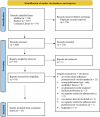Influenza and pneumococcal vaccines uptake among pharmacists: systematic review and meta-analysis
- PMID: 40595446
- PMCID: PMC12218444
- DOI: 10.1038/s43856-025-00976-7
Influenza and pneumococcal vaccines uptake among pharmacists: systematic review and meta-analysis
Abstract
Background: Influenza virus and pneumococcal infections are associated with serious health risks resulting from complications. Vaccinations are an effective method of preventing them. Pharmacists can play an essential role in promoting and administering vaccines. High vaccination rates among pharmacists could increase their credibility as vaccination advocates. The review aims to discuss the influenza and pneumococcal vaccination coverage among pharmacists and factors influencing the willingness to vaccinate.
Methods: The systematic review was performed according to PRISMA guidelines across three medical databases: Medline (via PubMed), Embase (via OVID), and Cochrane Library. The quality assessment of the study was carried out using The Quality Assessment Tool for Observational Cohort and Cross-Sectional Studies. A meta-analysis was also conducted to estimate pharmacists' overall influenza vaccination coverage, incorporating an analysis of vaccination trends before and during the COVID-19 pandemic.
Results: The meta-analysis of 6194 observations and 3585 events reveals an overall influenza vaccination coverage among pharmacists of 50.78% under a random effects model, with a 95% confidence interval ranging from 36.20% to 65.22%. Only one retrieved study analyzes pharmacists' vaccination coverage against pneumococci. According to the findings, 20.8% of the participants in the study were vaccinated against pneumococci.
Conclusions: The current influenza vaccination rate among pharmacists is moderate, and concerted efforts are needed to increase it. This involves implementing continuous education, beginning at the pharmacy degree stage.
Plain language summary
Immunization is the most effective method of preventing infectious diseases. We used uptake of immunization against influenza and pneumococcal among pharmacists to estimate the coverage within the profession and as a surrogate measure of their influence on the general public. We evaluated 18 studies, only one of which was on pneumococcus immunization. They find that influenza vaccination rates among pharmacists varied widely, from 7% to 95%, with an average of about 50.78%. They note that pharmacists often choose to vaccinate to protect their patients and families. However, some pharmacists are hesitant due to doubts about vaccine effectiveness and safety. The study suggests that increasing education about vaccines could improve vaccination rates among pharmacists. This research highlights the need for better strategies to encourage pharmacists to get vaccinated, which could help increase overall vaccination rates in the community. Future efforts could focus on addressing misconceptions and improving access to vaccines.
© 2025. The Author(s).
Conflict of interest statement
Competing interests: The authors declare no competing interests.
Figures




Similar articles
-
Parents' and informal caregivers' views and experiences of communication about routine childhood vaccination: a synthesis of qualitative evidence.Cochrane Database Syst Rev. 2017 Feb 7;2(2):CD011787. doi: 10.1002/14651858.CD011787.pub2. Cochrane Database Syst Rev. 2017. PMID: 28169420 Free PMC article.
-
Vaccines for preventing influenza in healthy adults.Cochrane Database Syst Rev. 2018 Feb 1;2(2):CD001269. doi: 10.1002/14651858.CD001269.pub6. Cochrane Database Syst Rev. 2018. PMID: 29388196 Free PMC article.
-
Immunogenicity and seroefficacy of pneumococcal conjugate vaccines: a systematic review and network meta-analysis.Health Technol Assess. 2024 Jul;28(34):1-109. doi: 10.3310/YWHA3079. Health Technol Assess. 2024. PMID: 39046101 Free PMC article.
-
Vaccines for preventing influenza in healthy children.Cochrane Database Syst Rev. 2018 Feb 1;2(2):CD004879. doi: 10.1002/14651858.CD004879.pub5. Cochrane Database Syst Rev. 2018. PMID: 29388195 Free PMC article.
-
Interventions targeted at women to encourage the uptake of cervical screening.Cochrane Database Syst Rev. 2021 Sep 6;9(9):CD002834. doi: 10.1002/14651858.CD002834.pub3. Cochrane Database Syst Rev. 2021. PMID: 34694000 Free PMC article.
References
-
- Uyeki, T. M. High-risk groups for influenza complications. JAMA324, 2334 (2020). - PubMed
-
- Buchy, P. & Badur, S. Who and when to vaccinate against influenza. Int. J. Infect. Dis.93, 375–387 (2020). - PubMed
-
- Campling, J. et al. A review of evidence for pneumococcal vaccination in adults at increased risk of pneumococcal disease: risk group definitions and optimization of vaccination coverage in the United Kingdom. Expert Rev. Vaccines.22, 785–800 (2023). - PubMed
LinkOut - more resources
Full Text Sources

